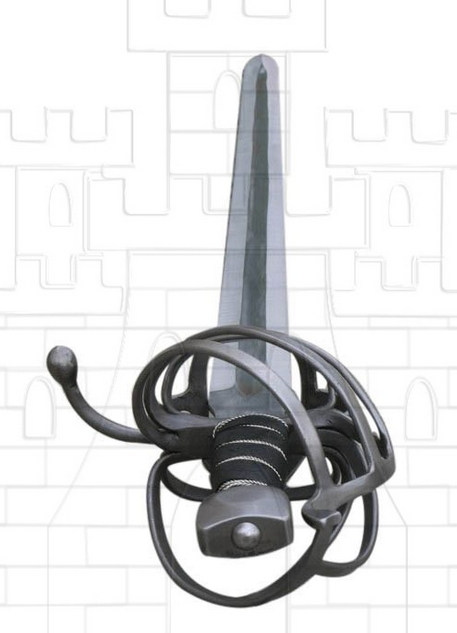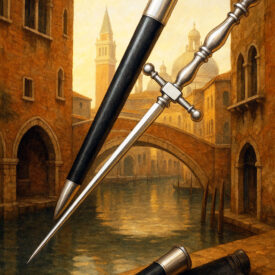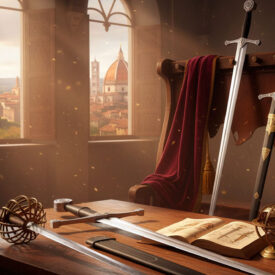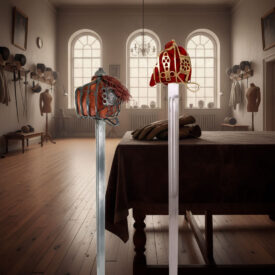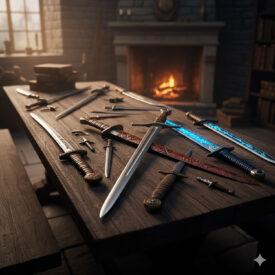What does a cage-shaped hilt have to tell stories of mercenaries, duels, and the majesty of Renaissance Venice? The Italian Schiavona Sword, known as the Schiavona, is not just a cutting tool: it is a metallic fragment of identity, power, and technique that traveled from the Adriatic coasts to museum collections and the hands of modern artisans who recreate the past.
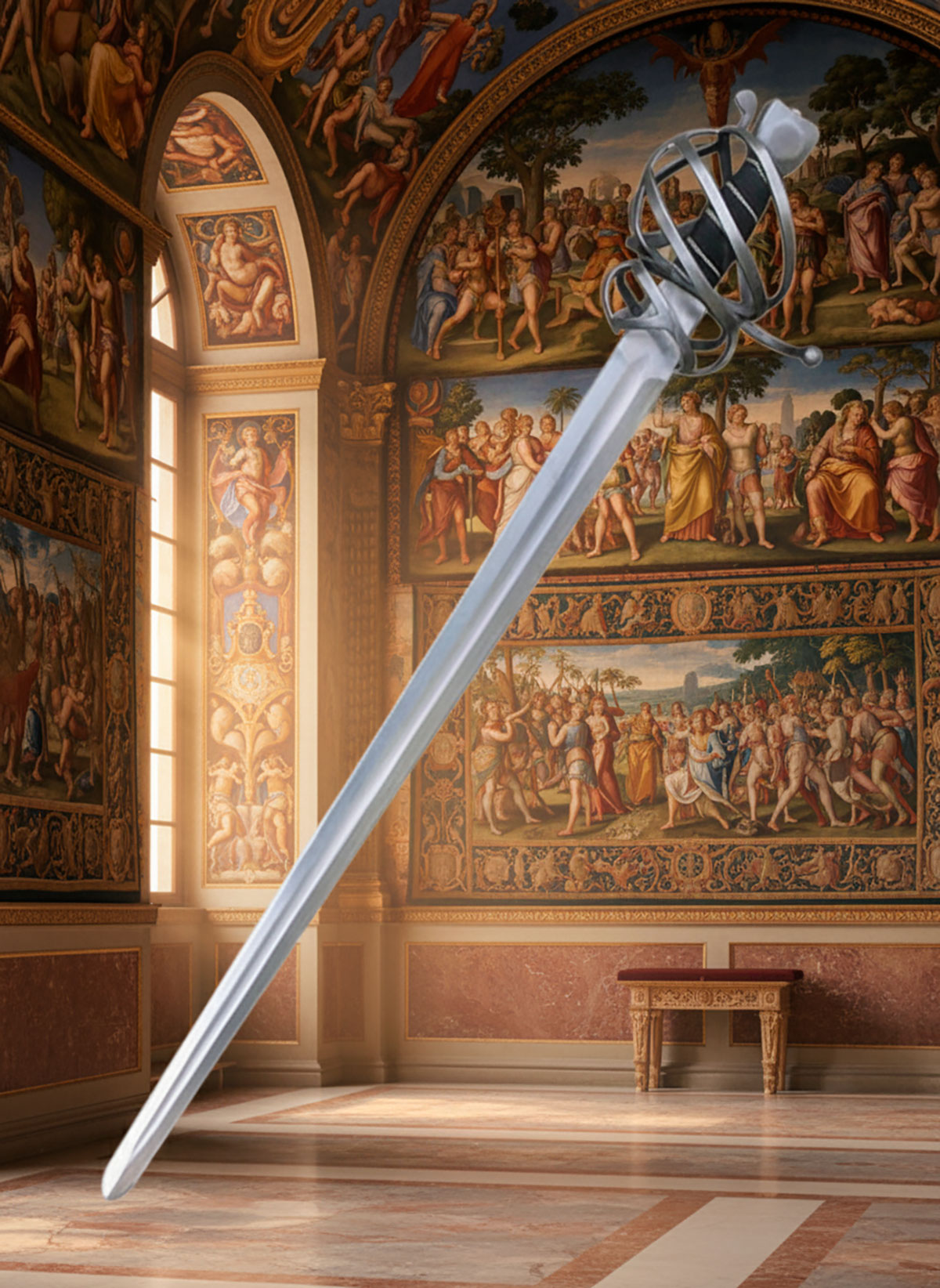
A name, a provenance: why it’s called Schiavona
The name Schiavona comes from the Slavic mercenaries who served in the Guard of the Doge of Venice. These men, often from Dalmatia, Istria, and other Balkan regions, carried a sword that identified with their ethnicity and their role: protection, presence, and effectiveness. Over time, this sword became distinctive for its basket-shaped guard, and the denomination became fixed in Italian inventories, texts, and armories.
What you will learn in this article
You will have a complete guide to the historical origin of the Schiavona, its technical and stylistic evolution, how it was used in combat, its dimensions and constructive characteristics, a comparison with other Renaissance swords, and how to understand a modern replica from the perspective of authenticity and conservation practices.
The essential chronology of the Schiavona
The history of the Schiavona Sword unfolds between the late 15th and 17th centuries, with milestones in its design and dissemination. This chronology helps to situate the sword in its historical and technological context.
| Era | Event |
|---|---|
| Late 15th century / Early 16th century | Its development begins in Italy; in this early phase, the guards were simpler, similar to those of early katzbalgers. |
| 16th century | The Schiavona becomes one of the most prominent swords of the Modern Age. The Venetian version presents forms that will lead to the most protected variants of the 17th century. |
| Early 17th century | A specific design of Italian Schiavona forming part of the collection of the Military History Museum in Prague is recorded. |
| 17th century | It reaches its most known and elaborate form in Italy, with an extremely closed and complex hilt for complete hand protection. |
| Summary: The Schiavona sword emerged in the early 16th century in Italy and evolved throughout the 17th century, developing the characteristics of its distinctive basket hilt. | |
Design and anatomy of the Schiavona Sword
The Schiavona presents three constructive blocks that you must understand: the guard (or basket), the hilt, and the blade. Each contributes functionality and symbolic weight that made it appreciated by officers and mercenaries.
The guard: a cage that protects and declares status
Its guard, known as a “loop guard” or simply “basket,” is formed by metal bars that completely enclose the hand. This design was not born out of aesthetic whim: it offered protection against cuts and blows, preventing the hand from being exposed during thrusts or parries. Furthermore, the complexity of the guard became a display of the armorer’s skill.
The hilt and pommel
The hilt is usually short, designed for one hand, and covered with wood and leather. The pommel, often welded to the tang, helps balance the sword. In many preserved pieces, attention to comfort and firm grip is evident, which favored cutting maneuvers and point control.
The blade: cut and force
The blades of the Schiavona are mostly cutting blades, robust and relatively wide compared to stilettos. Some blades feature a waist or indentation to lighten weight without sacrificing cutting inertia. In original examples, dimensions vary, but blades ranging between 70 and 95 cm are typical.
How the Schiavona was handled in combat
The Schiavona is a versatile sword: its construction favors powerful cuts and, with technique, controlled thrusts. The existence of an enveloping basket allows the combatant to support or rotate the hand to control the point, even introducing a finger over the quillon in some practices to improve weapon control in tactical deployment.
In the Renaissance battlefield, where the mix of polearms, arquebuses, and mounted combatants was the rule, the Schiavona offered an intermediate solution: enough power to wound at short range and hand protection that increased survival chances in close combat.
Historical context: the Schiavona in the Modern Age
During the 16th and 17th centuries, Europe experienced a technological acceleration in weaponry. Even so, the sword remained an essential complement. The Schiavona had its heyday at a time when armor was being reduced and martial fashion demanded weapons that were both useful and elegant. Its association with the Venetian Doge’s Guard gave it an aura of prestige that transcended the purely military.
Multiple functions: war, parade, and status
Beyond its effectiveness in combat, the Schiavona served a ceremonial function. Officers and dignitaries carried it as a sign of rank. The ornamentation (brasswork, engravings, inlays) turned some pieces into true works of art.
Technical comparison: Schiavona, rapier, and katzbalger
To better understand the uniqueness of the Schiavona, let’s compare it with other contemporary swords.
| Aspect | Schiavona | Rapier | Katzbalger |
|---|---|---|---|
| Function | Cutting and thrusting, hand protection | Thrusting predominates; dueling and light cuts | Light cutting, infantry weapon |
| Guard | Complex basket/hilt | Ring and bar guard or cup | Simple, often trimmed guard |
| Blade | Wide, medium-high weight | Thin, long, and sharp for thrusting | Wide and short |
| Social use | Military and ceremonial | Primarily dueling and civil fashion | Infantry, practical use |
Measurements and materials: what to expect in a historical piece or replica
Original pieces and historical replicas show defined ranges. A replica inspired by an early 17th-century model might measure around 100 cm in total, with a 77 cm blade and a 15 cm hilt, and weigh around 1.7 kg, though variations exist. Original blades were forged from quality steel and often subjected to heat treatment and tempering to balance hardness and flexibility.
Construction: tang and assembly
Most preserved Schiavonas show a full tang, where the blade extends through the hilt and the pommel can be welded. This provides structural strength and allows for repairs and adjustments, something essential when the sword is an instrument of daily use.
A comparative table of typical measurements
| Element | Typical Measurement | Observations |
|---|---|---|
| Total length | 95-105 cm | Varies by era and manufacturer |
| Blade length | 70-95 cm | Longer blades appear in gala variants |
| Weight | 1.1-1.8 kg | Ornamented pieces usually weigh more |
| Blade width | 2.5-4 cm | Robust blades designed for cutting |
The Schiavona in the Venetian arsenal and its symbolism
The presence of Slavic mercenaries in the Doge’s Guard gave Venice a cosmopolitan character. The sword they carried came to represent not only military function but also a sign of cultural identity. Iconographic vestiges and descriptions from the period emphasize its use in civilian guards and ceremonies.
Reproductions and replicas: how to read a modern replica
When you look at a contemporary replica, evaluate three things: fidelity in proportions (blade and hilt length), assembly technique (full tang and pommel), and steel quality. Replicas aimed at historical reenactment usually offer a good balance between authenticity and safety for practice.
It is valuable to remember that many current replicas reinterpret ornamental details to adapt to aesthetic demand, without detracting from the piece’s value as an object of study or exhibition in reenactments.
Maintenance and conservation of a Schiavona
Proper care prolongs the life of a sword. Cleaning the blade, removing moisture, and applying a thin layer of oil are essential practices. Avoid unnecessary blows against hard surfaces and periodically check the condition of the hilt and pommel.
Technical conservation tips
- Regular cleaning: remove sweat and dust residues after handling.
- Protection against oxidation: a light coat of mineral oil on the blade helps prevent corrosion.
- Storage: dry and protected places, avoiding airtight cases that trap moisture.
- Inspections: check the seating of the pommel and the integrity of the tang.
The Schiavona in culture and collection
Museums and private collections preserve specimens that illustrate the technical and ornamental evolution of the Schiavona. These swords appear in Venetian inventories, military iconographies, and European collections that document the cultural exchange of the Renaissance.
Comparison with emerging firearms: coexistence and transformation
The arrival and gradual improvement of firearms did not immediately nullify the usefulness of swords. The Schiavona coexisted with arquebuses and pistols, adapting to a scenario where mobility, formation, and personal protection were determining variables.
Why the sword survived
- Versatility in close combat.
- Social and ceremonial symbolism.
- Economy and availability compared to early firearms.
Reading sources and museums: clues for the researcher
If you are researching the Schiavona, look for references in Venetian inventories, military museum catalogs, and studies on Renaissance armory. The registration of pieces in European collections, such as the one mentioned in Prague, allows for the reconstruction of typologies and regional variations.
Final reflections on a sword that encapsulates an era
The Italian Schiavona Sword is a perfect synthesis of functionality and appearance. Its basket guard, cutting blades, and its link with the Venetian Guard make it a tangible witness to the transition between medieval warfare and armed modernity. Understanding it means glimpsing the complex network of influences, techniques, and social needs of the Renaissance.

